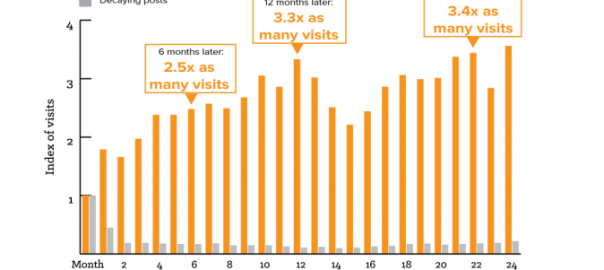
There are two kinds of blog posts: the standard, run-of-the-mill posts that perform reasonably well but don’t bring traffic to your website long-term and the shiny gems that bring in more and more visits over time. Those “shiny gems” are called “Compounding Blog Posts”. Instead of decaying, like other posts, they’re constantly working to help you attract more visits. Compounding posts typically represent about 10 percent of all blogs published, but they bring in as much as 38 percent of your traffic, according to a HubSpot report. Just one compounding post is generating as much traffic as six decaying posts. But how do you write compounding posts? Are they random special snowflakes or can marketers plan for them in editorial calendars?
Characteristics of a Compounding Blog Post
So it’s true: compounding blog posts represent a huge potential in terms of traffic growth to your blog and website. And while it may seem like they appear randomly in your previously published blogs, there are certain characteristics that many of these posts have in common – characteristics that you can replicate to build posts that are more likely to compound in the future:
- What, how, why, and best. These words occur the most frequently in the titles of compounding blog posts.
- Tactical Topics. When you’re giving your audience a practical guide that they can use and apply to their life, they will be more likely to read the post and share it with others.
- Six to 13 words is the key title length. The correlation between title length and long term views is at the 11 to 13 word threshold, but six to 13 words is the key length. Anything over 13 words tends to be too long and specific; anything shorter may not accurately attract visitors.
- Keep SEO in mind. Keywords that show long-term search volume and are good difficulty targets are your best chance for getting listed in search results. Use these keywords for posts you hope to compound. Use long tail keyword phrases based on your target core keywords. These often provide excelent tactical queries that make for traffic-generating machines.
- Make it Easy to Read. Your blog itself should follow formatting best practices: Subheadings, bullets, short paragraphs, and easily digestible content are key.
- Use Images. Enhancing your written content with appropriate imagery is always an asset. Especially in tactical content, when your goal is to show the reader how to do something, including images and illustrations of the process is a key component.
How to Identify a Compounding Post in your Analytics
Standard “Decaying” posts receive most of their traffic when they’re first published; they don’t represent a long term traffic solution. Compounding posts, however, are often not the most popular when initially launched. Instead, they steadily produce more and more visitors every month, until they’ve surpassed the traffic they brought in at initial launch (and still continue to grow). Here’s how HubSpot found decaying and compounding posts differ over time:

Source: HubSpot
In this figure, you’ll see that decaying posts (grey) quickly drop in months two and three, before traffic levels off in months following. A compounding post (orange) will receive two and a half times as many visits than in its initial launch month just six months after publication. Two years later, the number of visits per month has tripled.
To find your compounding posts, sort your blog analytics by most viewed. It’s likely that your compounding posts are in the top 10 percent of those. Look at monthly traffic for these posts to determine if they’re month over month growth. When you’ve isolated the top performers, compare them to each other. The common threads in these posts, in addition to the previously listed commonalities of all compounding posts, should be the backbone of your strategy.
Posts Not Likely to Compound
Just as there are some elements that compounding posts have in common, there are also characteristics of decaying posts to watch out for. Posts that are highly likely to decay are:
- Newsjacking Posts. These posts, which play on current events, see a spike in traffic when they’re first published; however, over time, they do not continue to bring in traffic because searchers stop looking for the content.
- Highly focused topics. A narrowly focused blog post, while it speaks to segment of your overall audience, is not likely to bring in a large volume of traffic over time.
When writing blog titles, avoid dating them in a specific way, for example “___ of the Month,” or “This year’s greatest _____.” Also avoid referencing a specific timely item, such as “New Research Finds _______.” These types of titles tell readers the information they’ve encountered is likely outdated, which hinders potential.
Should You Expect All Posts to Compound?
Blog posts that grow over time do represent a huge opportunity for attracting visitors and converting leads, but you can’t expect every post you write to generate traffic long term. Writing titles that are likely to compound should be one step in your overall blogging strategy, but it’s important to balance broad, easy-to-read overview posts with in depth content that thoroughly explores a topic; with reactions to news items. Tactical guides and how-tos should be balanced by strategic content. It’s all about building a balanced editorial calendar that will help you meet your marketing goals.
Digital & Social Articles on Business 2 Community
(101)






